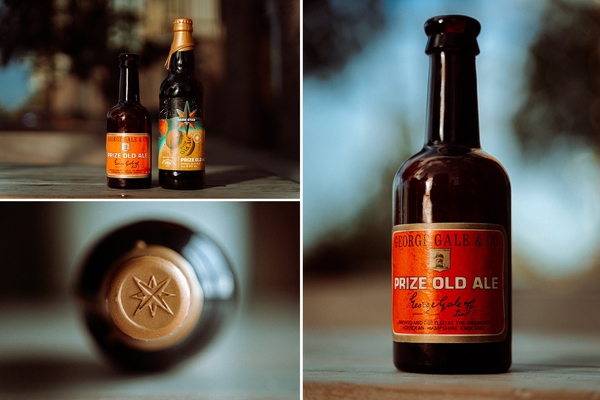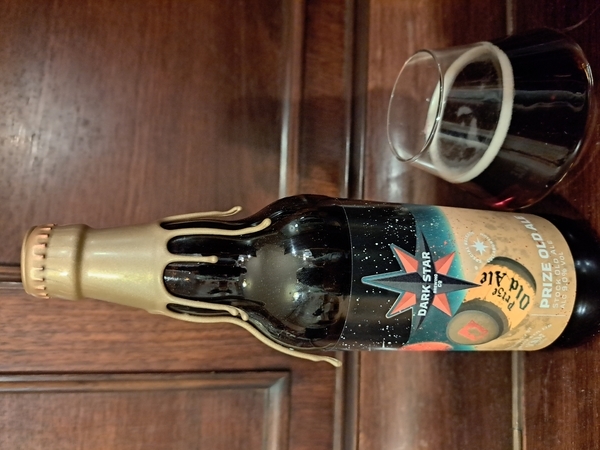Classic stock ale makes record return
Added: Thursday, November 23rd 2023

Dark Star’s Prize Old Ale has been restored with such acclaim and demand that a new vintage has been released just a year after the 2022 edition. (Photo Sean McEmerson @seanislegend.)
The name Old Ale is a misnomer – the beer belongs to an older family of English beers known as Stock Ales that date back to the 17th century. They have much in common with the Oud Bruin (Old Brown) and Sour Red beers of Flanders and the spontaneous fermentation lambic beers from the Senne Valley region of Belgium.
But Stock Ales should be judged in their own right as a distinctive English style. The name is thought to have derived from the fact that the beers were aged or stocked for long periods, unlike running beers that were consumed soon after production ended. Prize Old Ale is not dissimilar to Greene King’s Strong Suffolk Ale that’s a blend of two beers, one aged for a year or more in oak tuns and blended with a fresh young beer.
Stock Ales are also similar to the Spanish wine industry’s solera system for making sherry, where one aged batch is topped up with fresh wine once a year. In the case of Prize Old Ale, the beer is a blend of a fresh beer that is just two months old with a beer that has been aged for several years.
The aged beer has been stored in oak vessels and has been attacked by Brettanomyces, lactobacillus and other wild yeasts and bacteria trapped in the wood.
PoA, as it’s known for short, was first brewed in 1923 by a brewer called William Mears at Gale’s brewery in Horndean, Hampshire. It was made with pale and black malts with torrefied wheat and it was boiled for two hours with Fuggles and Goldings hops. The long boil caramelised some of the malt sugar and created a dark amber beer.
It was fermented in vessels made from New Zealand wood and was matured for between six months and a year. The vessels were home to colonies of yeast and bacteria that ate the remaining malt sugars.
In 2005 Fuller’s in Chiswick, West London, bought Gale’s and closed the brewery a year later. Fuller’s head brewer John Keeling had a final 80-barrel batch of PoA brewed at Horndean and he added a new batch at Chiswick.
He then blended 20 barrels of fresh beer with 20 barrels of aged beer. John says the sales team at Fuller’s “hated PoA and didn’t want to promote it.” He hid 42 barrels of the beer in the Chiswick tank room and made only two batches of the beer before he retired.
Five years later, Henry Kirk, a brewer at Fuller’s, discovered the beer in its tank. “I thought it smelt liked Rodenbach Grand Cru,” he says. That’s a beer brewed at the Rodenbach Brewery in Roeselare in Belgium: beer is aged in giant oak vats and blended with fresh beer in a ratio of two thirds aged to one third fresh beer.
There’s an interesting historic twist here, as in the 1870s, a member of the Rodenbach family, Eugene, toured a number of British breweries to learn how stock ales and porter were brewed and then returned to Roeselare to develop his own aged and blended “sour red” beers.
Henry Kirk campaigned to have PoA launched again. Then in 2019 Asahi bought Fuller’s and Henry was transferred to the Dark Star brewery in Sussex. He brewed a new batch of PoA but the launch was delayed by Covid until 2022. It was brewed with 73% Maris Otter pale malt, 17% invert sugar, 8% torrefied wheat and 2% black malt. The hops were once again Fuggles and Goldings.

The batch of 3,600 bottles (above) sold out within 48 hours. It was the fastest-selling beer every brewed at Dark Star. This remarkable success was marred six weeks later when Asahi announced it was closing Dark Star and all the beers would be transferred to its Meantime Brewery in Greenwich.
This year, brewer Sven Hartmann produced 30 barrels of fresh beer and blended it with aged beer. Maris Otter was replaced with regular pale malt. The original Gale’s yeast is still used as it gives a distinctive fruity character to beer. The beer is not filtered and will improvce with age.
The new beer was produced in July, blended in August and then matured for three months. 3,000 500ml bottles have been produced and they are available £7 a bottle or £80 for 12 bottles online from
www.darkstarbrewing.co.uk/products/prize-old-ale
A draught version is on sale in two London pubs, the Harp in Covent Garden and the Old Mitre in Holborn, along with the Duke of Wellington at Shoreham-by-Sea, Sussex, which is owned by Rob Jones, the brewer who founded Dark Star in Brighton.
The beer is astonishingly complex. It pours a deep russet brown with a dense collar of foam. The aroma is dominated by a musty note brewers call “horse blanket” with notes of burnt raisin and sultana fruit, wholemeal biscuits, spice and pepper from the hops, with touches of bitter chocolate, espresso coffee, liquorice and butterscotch. The palate has creamy malt, burnt fruit, spicy hops, coffee, butterscotch, liquorice and acidic notes. The finish is bittersweet with sour fruit, peppery hops, chocolate, coffee and butterscotch with a dry and acidic finale.








